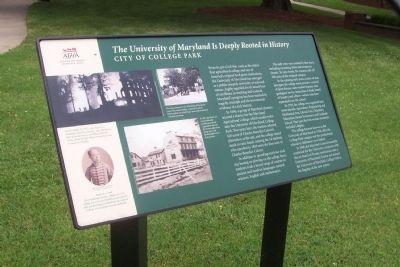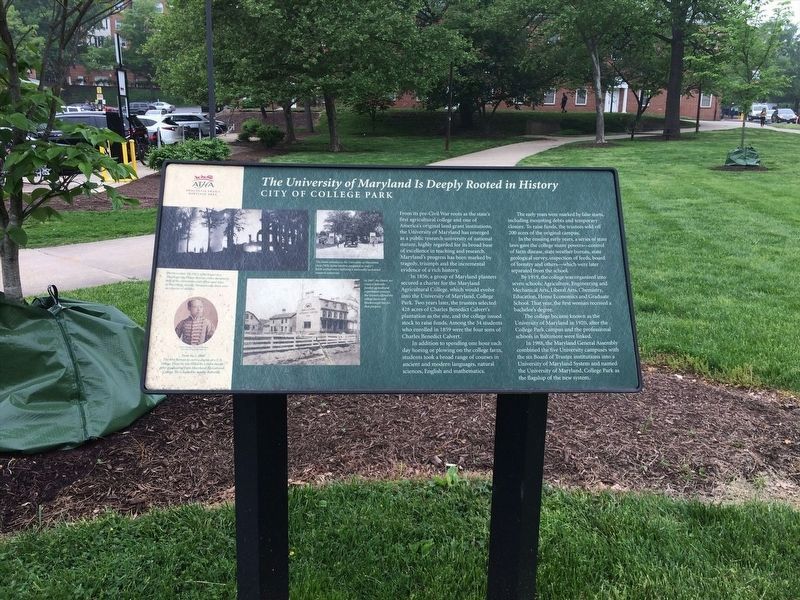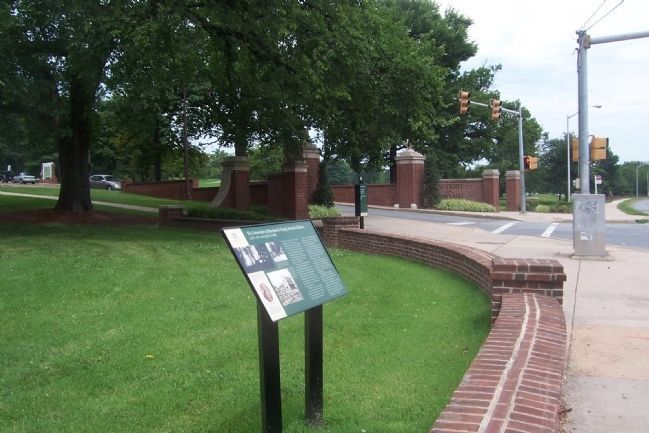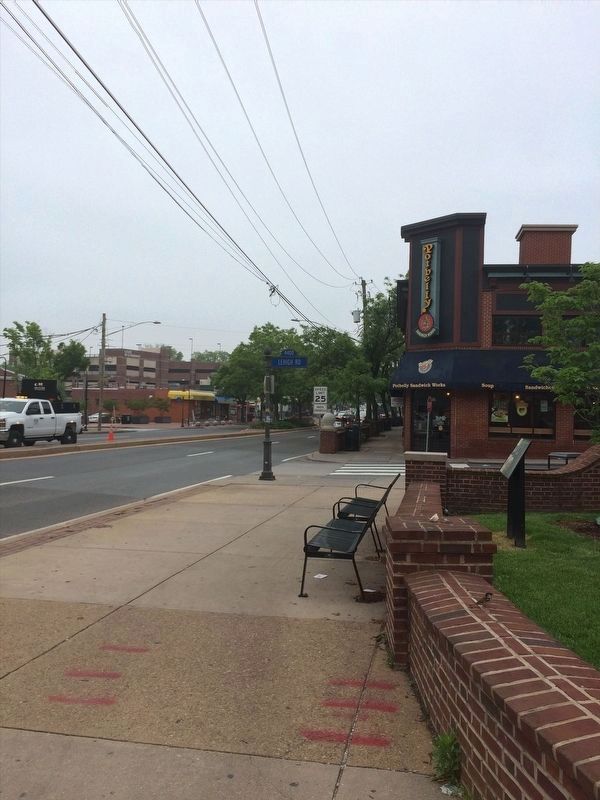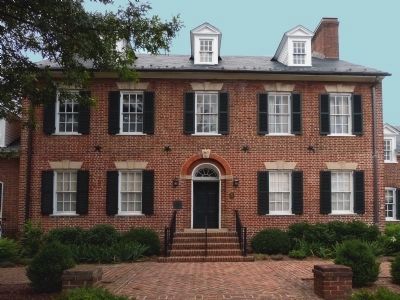College Park in Prince George's County, Maryland — The American Northeast (Mid-Atlantic)
"The University of Maryland Is Deeply Rooted in History"
City of College Park
— Anacostia Trails Heritage Area —
Inscription.
From its pre-Civil War roots as the state’s first agricultural college and one of America’s original land grant institutions, the University of Maryland has emerged as a public research university of national stature, highly regarded for its broad base of excellence in teaching and research. Maryland's progress has been marked by tragedy, triumph and the incremental evidence of a rich history.
In 1856, a group of Maryland planters secured a charter for the Maryland Agricultural College, which would evolve into the University of Maryland, College Park. Two years later, the trustees selected 428 acres of Charles Benedict Calvert’s plantation as the site, and the college issued stock to raise funds. Among the 34 students who enrolled in 1859 were the four sons of Charles Benedict Calvert.
In addition to spending one hour each day hoeing or plowing on the college farm, students took a broad range of courses in ancient and modern languages, natural sciences, English and mathematics.
The early years were marked by false starts, including mounting debts and temporary closure. To raise funds, the trustees sold off 200 acres of the original campus.
In the ensuing early years, a series of state laws gave the college many powers—control of farm disease, state weather bureau, state geological survey, inspection of feeds, board of forestry and others—which were later separated from the school. By 1919, the college was organized into seven schools: Agriculture, Engineering and Mechanical Arts, Liberal Arts, Chemistry, Education, Home Economics, and Graduate School. That year, the first woman received a bachelor’s degree.
The college became known as the University of Maryland in 1920, after the College Park campus and the professional schools in Baltimore were linked.
In 1988, the Maryland General Assembly combined the five University campuses with the six Board of Trustee institutions into a University of Maryland System and named the University of Maryland, College Park as the flagship of the new system.
[Captions:]
On November 29, 1912, a fire begun at a Thanksgiving Dance destroys every dormitory, half of the classrooms and offices and most of the college records. Miraculously, there were no injuries or deaths.
Pyon Su, c. 1888. The first Korean to earn a degree at a U.S. college, Pyon Su was killed by a train shortly after graduating from Maryland Agricultural College. He is buried in nearby Beltsville.
The main entrance to the University of Maryland, circa 1930, seems modest compared to today’s brick-arched entry, befitting a nationally acclaimed research university.
In 1887, the Hatch Act created federally funded agricultural experiment stations; the trustees offered the college farm and Rossborough Inn for that purpose.
Erected 2008 by Anacostia Trails Heritage Area, Maryland Heritage Area Authority.
Topics. This historical marker is listed in these topic lists: Agriculture • Education • Notable Places. A significant historical date for this entry is November 29, 1912.
Location. 38° 58.921′ N, 76° 56.288′ W. Marker is in College Park, Maryland, in Prince George's County. Marker is at the intersection of Baltimore Avenue (U.S. 1) and Regents Drive when traveling south on Baltimore Avenue. Touch for map. Marker is at or near this postal address: 7490 Baltimore Ave, College Park MD 20740, United States of America. Touch for directions.
Other nearby markers. At least 8 other markers are within walking distance of this marker. "From Stagecoach to Streetcar to Subway: A College Town Emerges" (about 400 feet away, measured in a direct line); Graham Cracker (about 800 feet away); Class of 2002 (approx. 0.2 miles away); Washington Quad Renovation (approx. 0.2 miles away); University of Maryland Memorial Chapel (approx. 0.2 miles away); “On the Shoulders of Giants” (approx. 0.2 miles away); The Rossborough Inn (approx. ¼ mile away); Calvert Hall (approx. ¼ mile away). Touch for a list and map of all markers in College Park.
Also see . . .
1. Univ. of MD, College Park During the Civil War. 150 years before the Terrapins were sporting the Maryland state flag on their helmets, their campus predecessors were choosing whether to don gray or blue uniforms in a fratricidal conflict tearing apart their state and nation. This weekend, I visited a new exhibit at the University of Maryland's Hornbake Library, "A College Divided: Maryland Agricultural College and the Civil War," which explores the impact that the Civil War had on the then fledgling institution. Through a series of posters, the exhibit highlights significant roles, both for the Union and Confederate causes, played by students, faculty and alumni. (Submitted on September 9, 2011, by Steven Berkowitz of Annnandale, Virginia.)
2. Wikipedia entry for University of Maryland, College Park. (Submitted on August 1, 2008, by Richard E. Miller of Oxon Hill, Maryland.)
3. Wikipedia entry for Charles Benedict Calvert. founder of the Maryland Agricultural College. (Submitted on August 1, 2008, by Richard E. Miller of Oxon Hill, Maryland.)
Credits. This page was last revised on March 22, 2023. It was originally submitted on July 23, 2008, by Richard E. Miller of Oxon Hill, Maryland. This page has been viewed 1,943 times since then and 30 times this year. Last updated on October 30, 2008, by Richard E. Miller of Oxon Hill, Maryland. Photos: 1. submitted on July 23, 2008, by Richard E. Miller of Oxon Hill, Maryland. 2. submitted on January 9, 2022, by Adam Margolis of Mission Viejo, California. 3. submitted on July 23, 2008, by Richard E. Miller of Oxon Hill, Maryland. 4. submitted on January 9, 2022, by Adam Margolis of Mission Viejo, California. 5. submitted on July 28, 2013, by Allen C. Browne of Silver Spring, Maryland. • Kevin W. was the editor who published this page.
